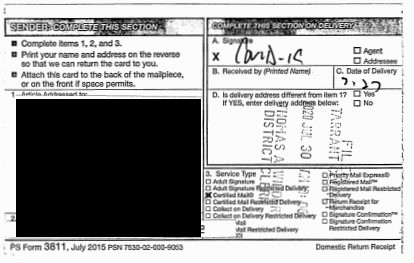Impact of COVID-19 on Service of Process
Proper service is one of the first things that attorneys look for in lawsuits. But in the current COVID-19 climate, attorneys need to be on the lookout for developments in how service by certified mail is actually being carried out.
The Texas Rules of Civil Procedure authorize citation to be served by mailing a copy of the citation and petition to the defendant by registered or certified mail, return receipt requested.1 Rule 107(c) further requires: “When the citation was served by registered or certified mail as authorized by Rule 106, the return by the officer or authorized person must also contain the return receipt with the addressee’s signature.”
But COVID-19 has caused the Postal Service to change the signature requirements for Certified Mail in order to follow the CDC’s social distancing guidance and reduce chances for possible COVID-19 spread. The Postal Service details on its website the temporary modification to handling mail that requires customer signatures:
- Avoid ringing the doorbell when possible. Knock on the customer’s door. Avoid areas that may be frequently touched when knocking.
- While maintaining a safe, appropriate distance, employees will request the customer’s first initial and last name.
- For increased safety, employees will ask the customer to step back a safe distance or close the screen door/door so that they may leave the item in the mail receptacle or appropriate location by the customer door.
- If there is no response, employees will follow the normal Notice Left process.
- If there are delivery points on the route where social distancing recommendations are difficult to follow, alternative delivery methods can be explored.2
Postal Service employees “will request the customer’s first initial and last name so that the employee can enter the information on the electronic screen or hard copy items” and “will ask the customer to step back a safe distance or close the screen door/door so that they may leave the item in the mail receptacle or appropriate location by the customer door.”3
The Postal Service also noted:
It should be understood that our carriers are not signing for customers, but instead indicating that they have identified the customer to whom the item is being delivered. The new practice is deemed to fit within the requirements set forth in the Domestic Mail Manual (“DMM”). Under existing federal law, the Postal Service has authority to temporarily alter its procedures to ensure it can continue to provide postal services to nation. 39 U.S.C. §§ 101, 401, 403, 410 4
Despite this policy, it has become an increasing trend for some attorneys and their clients to discover a certified mail receipt that is marked “COVID-19” or “C-19” in lieu of a signature or first initial and last name:

These “COVID-19” receipts will no doubt create an uptick in motions for default judgment as defendants may not actually receive the petition and citation, and thus fail to timely answer the suit. Similarly, we can expect to see a corresponding rise in overturned default judgments, as it is difficult to see how a certified mail receipt like the above could constitute proper service, given the clear requirement of Rule 107(c) to contain “the addressee’s signature.” As attorneys, we must be sure to protect our clients’ interests and explore every option in representing a client. These days, that may not only mean contesting a default or filing a motion for new trial, but could also mean taking the proactive and slightly more expensive initial step of utilizing a process server to ensure that the defendant is properly served. Doing so will save both time and money for the client in the long run, and will keep the lawsuit moving forward.
____________________
Endnotes
1Tex. R. Civ. P. 103, 106.
2See USPS Coronavirus Updates for Business Customers, available at https://faq.usps.com/s/article/USPS-Coronavirus-Updates-for-Business-Customers.
3Id.
4Id.

